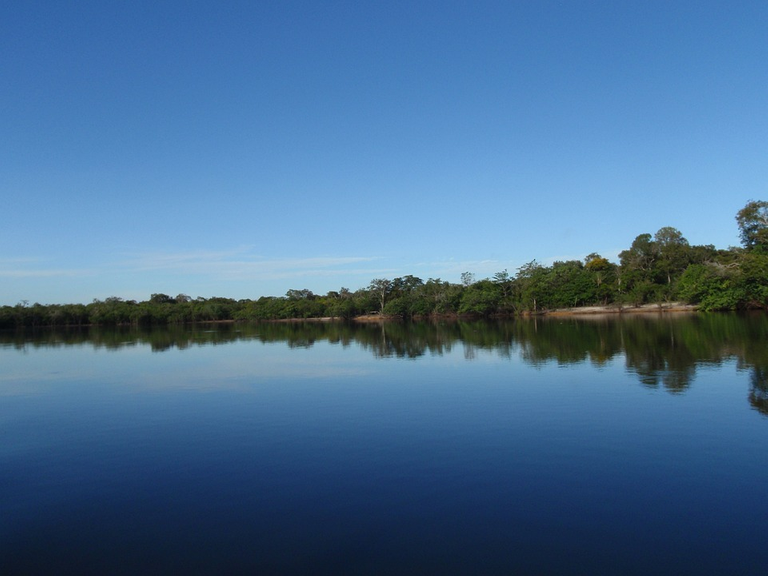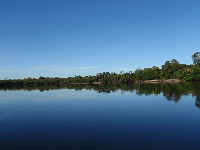
Across a river
My two companions - Carlos and Iñaky - and I left the enchantment of a nature that showed itself with all its power to enter a community of indigenous people, which we were destined to attend. I was going as a teacher, but along with the pedagogical resources I was also given medical equipment, medicines, sterile cotton and injectors. That same day I received a short training to perform, in addition to my teaching duties, nursing duties in a community whose language I did not speak.
My boss was an eminent anthropologist who had dedicated his life to studying the Sanemá nation, an indigenous population in decline due to diseases for which they had no antibodies, caused by contact with the Creoles. I was beginning my sociology studies when I met this passionate anthropologist who infected me with a great love for indigenism. A few months later I was receiving a necklace, made with seeds, as a simple act of welcome in the middle of the jungle.
I keep very clearly my childhood memories. I have always had great admiration for the simple and the small, a small fish moving in the water, the shapes of clouds, small flowers with few petals, dust particles floating in the wind, the colorful feathers of birds. Perhaps that is why I have consistently found it relatively easy to connect quickly with children.
When I met the Sanema children my soul found a treasure. In their faces, in their round eyes and in the sky of their astonished gazes (they with very straight hair were fascinated by the small waves of my hair) I found the beauty of the world in its purest state.
The range of colors used by the Sanema is reduced to those used in their body paints: black, gray and some shades of vermilion that can come from vegetables or clay. That first day, after noon, I sat on the floor and spread a lot of crayons and papers around me. Immediately the children approached me, ecstatic at the range of colors I was producing just by moving those crayons across the paper. I didn't know the language but I knew perfectly well what things can make children happy because I was happy with those things myself.
If it is to illustrate a way of overcoming obstacles I think that by placing the period at the end of the last paragraph I could be satisfied at this point in the story, but the examples of that experience among the Sanema flow in my memory and are struggling to find a place in this story.
Three weeks after I arrived I felt that I was part of the community, even though the women wore only a string of yarn over their hips and I kept my uncomfortable bluyines. I also kept my strange habit of sitting under a tree to read while the women always stayed around the fire when they were not picking fruit.
I would get up very early in the morning and start shouting the first word I learned in the Sanemá language: Macura. With that voice the Indians would come to the simple dispensary for me to distribute the medicines they needed. The chief of the tribe was among the first to arrive, as well as the witch elders. After distributing the pills, I concentrated on preparing the injections to be administered against tuberculosis.
The first few weeks I was a little nervous about that part of my job. It's not easy to inject chieftains and shamans without your hand shaking. Especially when I had witnessed the incredible knowledge of the world they held.
One evening I noticed that the routine of the community was not the same. The women were not around the fire roasting insects for their children and the men looked taciturn. Late in the afternoon an old woman approached me, took me by the hand and led me to the huge churuata where the whole clan slept. Lying in a hammock was a very young woman. Some women were rubbing her body, which revealed an advanced pregnancy. The mamma took my hand and placed it on the pregnant woman's belly and formulated a sentence in which I could only make out the word macura. I felt a sharp pang in my gut.
I spoke to my companions. It was too late to embark on a four-hour journey upriver to the nearest medical center. If the delivery did not happen at night, we would leave with the laboring woman at sunrise.
When the sun went down we began to hear singing. A large bonfire had been lit, filling the whole village with light. Little by little the witch elders, the cacique and the men sat around the fire. We, my companions and I, remained standing. We watched as they inoculated yopo, their sacred drug, through their nostrils, as the effect of the yopo became visible in their body contortions and in the dramatic grimaces on their faces, while the chanting increased in intensity from one moment to the next.
We were witnessing a ritual. The spirits were to come down, incarnated in the seers, to light the way to save the young mother and her first child. The husband of the laboring woman and her mother carried her to a large flat stone. There they laid her down while the priests sang over her those enigmatic chants, while sanctifying her with a bouquet of delicate leaves.
The cacique approached and with a dry branch made a naive drawing of the body of a pregnant woman. On the disproportionate belly, he drew a small body, in the difficult position of fetuses that come into the world breech, sitting in the birth canal.
The next morning we embarked, ready to get to the nearest dispensary. I held the hand of the parturient. We entered the dispensary five hours later. The doctor on duty auscultated the young woman and ordered an X-ray. It was an emergency, but the baby still had a heartbeat. An hour later I could see the newborn's face. God, how beautiful life is!
Sometime on the way back I was curious to look at the X-ray. I took it out of the envelope and held it up towards the sun. I clearly saw the figure of the fetus sitting in its mother's pelvis.
Thank you for reading!

A great experience in our lands as ancient as its people and customs. It's fascinating to have these kinds of encounters with such ancient tribes. I had a similar experience with the indigenous people of the Orinoco Delta and it really is something unique. Delighted with your story. Greetings.
Cross-cultural experiences are one of the most effective ways to enjoy the world with all its differences, thanks for reading, @fragozar01.
What an incredibly rewarding experience. WoW! I can’t imagine how difficult it must’ve been for you to administer medication and injections under those circumstances. The crayons were pure genius. That was such an excellent idea, because, it’s true, children delight in small things. I would love to see a native ritual in its traditional setting, and of course there’s some magic in the beliefs and rituals of ancient cultures - all people, even those unconnected to society and buried in the deepest jungles, pray in some way or another.
This is such a gorgeous piece and your love, sympathy and empathy for these endangered individuals shines through - they were so lucky to have you. ❤️💕🤗🥰😘🥰😘😘😘🥰❤️💕🤗🤗
Thank you so much for this thoughtful comment, @itsostylish.
Saving appearances we humans all have the same needs and suffer for the same things. This jungle experience has served me much more personally than the group I served in. I say that with absolute certainty. Thank you for your emotion and for the many hearts. A big hug.
I love the way you tell your stories, very imaginative. Keep up the good work
Thank you very much for reading and commenting, @nelson-george !
I enjoyed your story, how you undertook that expedition to that tribe, the experiences you had with the children and the young woman who gave birth to a child that was formed in the mother's womb in a bad position. Have a good night
Greetings, @rammargarita! It's interesting to put the colors and images of literature to one's own life. Thanks for reading!
Congratulations @gracielaacevedo! You have completed the following achievement on the Hive blockchain and have been rewarded with new badge(s):
Your next target is to reach 90000 upvotes.
You can view your badges on your board and compare yourself to others in the Ranking
If you no longer want to receive notifications, reply to this comment with the word
STOPCheck out the last post from @hivebuzz:
Tkanks, @hivebuzz !
You are welcome @gracielaacevedo, that's with pleasure! We wish you a happy buzzy week 😊👍🐝
What an incredible experience, @gracielaacevedo. Your storytelling skills are wonderful. I could picture this whole thing in cinematic fashion.
Creative nonfiction gives us the opportunity to tell our life stories, and to share them so they take on new life and can be experienced by others. What a wonderful way to keep this experience alive!
Writing this story made me realize how clear and present the feelings and emotions of that time are in me. Maybe someday I can put together and share the whole story. Thank you for your comment,@jayna it encourages me to keep writing.